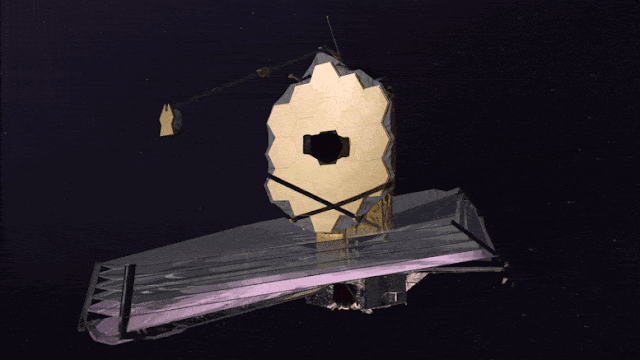NASA / ESA / CSA-ASC - James Webb Space Telescope (JWST) patch.
Feb 28, 2023
Image description: Stars and galaxies, mostly reddish in colour, are scattered across a dark background. In the foreground upper-right corner, a large elliptical galaxy is surrounded by many smaller similar galaxies in a cluster. These galaxies have bright centres and a diffuse white glow around them. The large galaxy has distorted images and arcs around it.
This observation from the NASA/ESA/CSA James Webb Space Telescope features the massive galaxy cluster RX J2129. Due to Gravitational lensing, this observation contains three different images of the same supernova-hosting galaxy. Gravitational lensing occurs when a massive celestial body causes a sufficient curvature of spacetime to bend the path of light travelling past or through it, almost like a vast lens. In this case, the lens is the galaxy cluster RX J2129, located around 3.2 billion light-years from Earth in the constellation Aquarius. Gravitational lensing can cause background objects to appear strangely distorted, as can be seen by the concentric arcs of light in the upper right of this image.
Astronomers discovered the supernova in the triply-lensed background galaxy using observations from the NASA/ESA Hubble Space Telescope, and they suspected that they had found a very distant Type Ia supernova. These supernovae always produce a fairly consistent luminosity — at the same distance, one looks as bright as any other — which makes them particularly helpful to astronomers. As their distance from Earth is proportional to how dim they appear in the night sky, objects with known brightness can be used as 'standard candles' to measure astronomical distances.
James Webb Space Telescope (JWST)
The almost uniform luminosity of a Type Ia supernova could also allow astronomers to understand how strongly the galaxy cluster RX J2129 is magnifying background objects, and therefore how massive the galaxy cluster is. As well as distorting the images of background objects, gravitational lenses can cause distant objects to appear much brighter than they would otherwise. If the gravitational lens magnifies something with a known brightness, such as a Type Ia supernova, then astronomers can use this to measure the ‘prescription’ of the gravitational lens.
This observation was captured by Webb's Near-InfraRed Camera to measure the brightness of the lensed supernova. As part of the same programme, NIRSpec spectroscopy of the supernova was also obtained, which will allow comparison of this distant supernova to Type Ia supernovae in the nearby Universe. This is an important way to verify that one of astronomers’ tried-and-tested methods of measuring vast distances works as expected.
Related links:
Near-InfraRed Camera: https://www.esa.int/Science_Exploration/Space_Science/Webb/Webb_s_instruments
NIRSpec: https://www.esa.int/Science_Exploration/Space_Science/NIRSpec_factsheet
James Webb Space Telescope (JWST): https://www.esa.int/Science_Exploration/Space_Science/Webb
Image, Animation, Text, Credits: ESA/Webb, NASA & CSA, P. Kelly.
Greetings, Orbiter.ch



